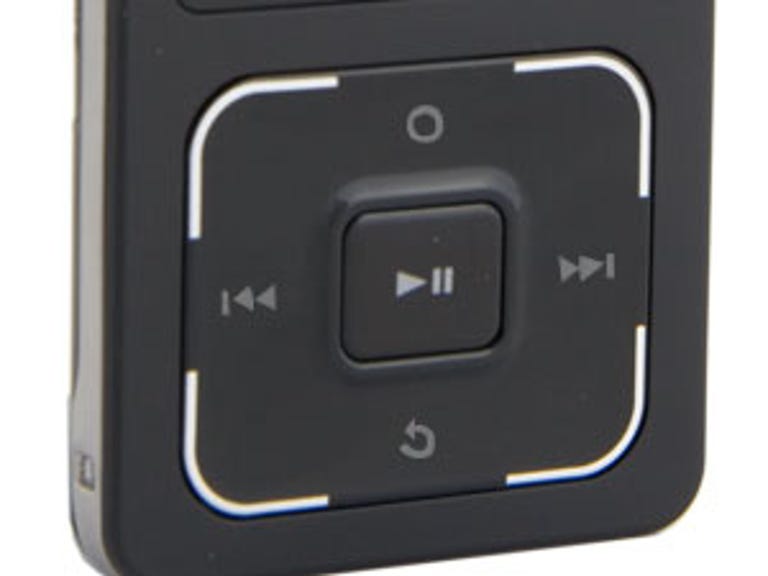 Why You Can Trust CNET
Why You Can Trust CNET Samsung F300 review: Samsung F300
The Samsung F300 combines phone and MP3 player like none before it. Styled along the lines of the iPod nano, this two-faced handset is impressively slim and even manages to pack a camera into its slender frame
Being two-faced certainly isn't a trait that you'd want in a friend, but is it one you'd want in a phone? Samsung seems to think so because that's what it's offering with the F300. On one side it looks pretty much like a standard mobile phone, while on the other it looks like an MP3 player styled along the lines of the iPod nano.
The Good
The Bad
The Bottom Line
There are plenty of phones on the market that have music features, but none that separate the music and call functions in such a dramatic way as Samsung has done here. The handset will be available free on contract from Carphone Warehouse, among others, or you can pick it up SIM-free on the Web for around £270.
Design
Despite the addition of screens on both sides of the phone, this blower is still impressively slim. It's around the same thickness as a standard CD case, but actually looks slightly slimmer thanks to the nicely rounded edges.
The phone side of the handset is taken up by a small keypad and an even smaller screen. Despite the keypad's diminutive dimensions it doesn't actually feel too cramped so you can work up a decent speed when texting.

The tiny screen is much more of an issue. It's only tall enough to show three lines of text at any one time. As a result it's used for just the most basic functions, such as looking up contacts or typing out SMS messages. When you access most of the phone's more advanced features, such as the Web browser, it displays a message saying 'switching' and you have to turn the handset over to use the larger screen on the MP3 player side.
That screen is excellent as not only is it bright and sharp, but it also makes colours look great. Perched underneath this is the touch-sensitive pad for navigating through the music menus, but more on those later.
The problem with the two-sided design is that it makes the phone hard to use. The constant swapping between one side and the other quickly becomes tiresome. For example, you have to switch to the larger screen to use the Web browser and you're pretty much forced to switch to it to view pictures and videos, because they look like thumbnail images on the small display.
It can also be hard to know what side to look at -- pick up the phone after leaving it on a table for a few minutes and both screens will be off to save on battery. We guarantee you'll look at the wrong side more times than not.
The menu system is also a mess and some of the entries are just badly labelled. For example, would you really expect to look for videos in a menu marked Albums? No, we wouldn't either, but that's where you find them on this handset.
Features
Pictures, music and videos can be transferred between the phone and a
PC via USB. When working over USB the phone can actually operate in two
modes. In the Media Transfer mode you can use Windows Media Player to
sync tracks, including music from subscription services such as
Napster.
If you opt for the PC Studio mode instead, you can take advantage of the easy-to-use PC software to edit the phone's calendar, manage SMS folders and transfer videos and snaps to and from the handset.
If you don't fancy using the USB lead, you can always transfer files via Bluetooth instead. As the phone supports the A2DP stereo profile it will also work with a stereo Bluetooth headset or speaker kit.
The phone is tri-band only and doesn't support 3G, so downloads are limited to GPRS or EDGE speeds. The camera features are slightly more interesting. The 2-megapixel sensor is mounted on the phone side of the device and is set as default to use the small screen as the view finder.
This is handy for taking self portraits, but if you want to take shots of someone else, you need to hit a soft key to swap the viewfinder on to the larger screen on the music side of the handset. The pictures have bags of colours, but as the camera only uses a 2-megapixel sensor, the detail isn't wonderful.
Performance
Performance-wise the phone has a few
positives, such as the clean call quality and crisp MP3 player screen,
however these are greatly outweighed by the negatives.
The battery is pretty anaemic, too. We only got two hours of talk time out of it, and that's without even touching the MP3 player. To get around this, Samsung supplies the phone with a case that incorporates a second battery, but this seriously bulks up the handset. Worse still is the fact that the flip design of the case makes the problem of switching between the phone side and MP3 side of the device even more of an issue.
Conclusion
Usually we'd applaud a manufacturer trying
to break from the mould to do something different, but on this phone
the different approach ends up being so unbelievably clunky that it's
difficult to see why Samsung bothered at all. This handset is a mess of
different ideas, feels sluggish to use and to top it all off has poor
battery life.
There really is nothing here to recommend. If you're looking for a neat music phone, we'd advise you to check out one of Sony Ericsson's Walkman handsets instead.
Edited by Jason Jenkins
Additional editing by Kate Macefield
